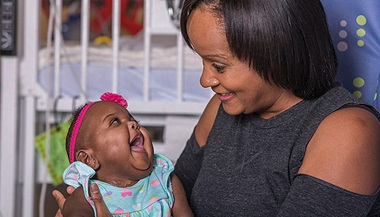Retinopathy of Prematurity (ROP)
Featured Expert:
In the United States, 1 in 10 babies are born preterm, according to the Centers for Disease Control and Prevention. Preterm, or premature, birth occurs when a baby is delivered before 37 week of pregnancy and weighs less than 2.5 pounds. Because of underdevelopment, babies born prematurely are at high risk of serious illness or diseases such as retinopathy of prematurity (ROP), which is a leading cause of blindness in infants.
Ophthalmologist Cody Richardson from the Wilmer Eye Institute, Johns Hopkins Medicine discusses ROP, what signs to look for and treatment therapies.
What is ROP?
The retina normally develops from about the fourth month of pregnancy all the way to the ninth month of pregnancy (or full term). In premature infants, the normal growth is interrupted. Retinopathy of prematurity happens because of underdeveloped retinal blood vessels in the eye of premature infants. Most of the time, the retina is still able to grow and develop to maturity. However, for some infants, these blood vessels try to grow but end up developing an abnormal amount of blood vessels, known as retinal neovascularization. This can cause bleeding, scarring and even retinal detachment or vision loss in some infants.
What are the stages of ROP?
ROP is defined by five stages:
- Stage 1 and 2 are mild, and do not require any treatment.
- Stage 3 occurs when the neovascularization starts. Many babies at this stage require treatment with lasers or injections. Some babies at this stage do not require treatment, but will be monitored very closely.
- Stage 4 is severe, and indicates there is a partial retinal detachment. This requires surgery, and there may be vision loss even with surgery.
- Stage 5 is very severe, and indicates a complete retinal detachment. Babies with stage 5 disease may have blindness even with surgery or other treatments.
Risk Factors for ROP
- Premature birth (less than 32 weeks)
- Low birth weight (less than 3 pounds)
ROP Signs and Symptoms
There are no visible signs or symptoms of ROP. All babies born at less than 32 weeks or with low birth weight are screened in the neonatal intensive care unit for ROP. During these examinations, an ophthalmologist will dilate the eyes and examine the retina to look for abnormal blood vessel growth. Sometimes, they will also take pictures of the retina with specialized cameras.
There are some signs that may develop later in babies who have had vision loss or retinal detachment:
- White pupils
- Strabismus (crossing or drifting of one or both eyes)
- Inability to track objects
Throughout their lives, children who had ROP are at higher risk of vision problems such as:
- Myopia (nearsightedness)
- Strabismus
- Amblyopia (lazy eye)
- Retinal detachment
Babies who had ROP will require eye exams throughout childhood.
ROP Treatments
There are a couple of therapies used to treat ROP at stage 3:
- Retinal laser (photocoagulation)
- Eye injections
There are two types of surgery used to treat ROP at stages 4 and 5:
- Vitrectomy
- Scleral buckle
ROP Screening
Premature infants should be screened by an ophthalmologist at least four to six weeks after delivery, with follow-up appointments based upon the severity and disease progression. Screening exams are typically performed while your baby is still in the neonatal intensive care unit, but additional exams may be needed after your baby leaves the hospital. Be sure to ask your doctor if your baby needs ongoing eye exams after discharge from the hospital.






